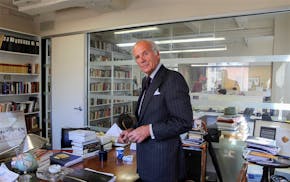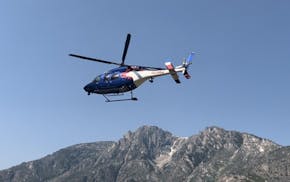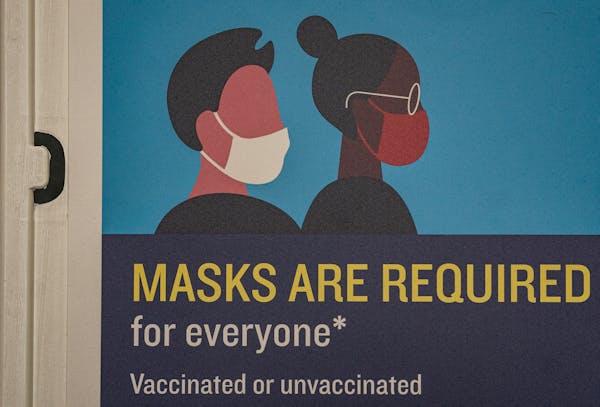The fast spread of the infectious omicron variant has prompted many people to try to upgrade to a higher quality medical mask. But that's easier said than done.
Anyone who has shopped for a mask online or in stores has discovered a dizzying array in a variety of shapes, sizes and colors. Knowing which mask to pick and making sure it's not a counterfeit requires the sleuthing skills of a forensic investigator. And once you choose one, it's still a gamble; many people discover they've ordered a mask that's too big or too small for their face or just doesn't fit right.
"No one has made this easy, that's for sure," said Bill Taubner, president of Bona Fide Masks, the exclusive distributor in the United States for both Powecom and Harley KN95 masks, which are from China. "A lot of people end up doing a lot of research."
Unlike cloth masks, high-quality masks — called N95s, KN95s and KF94s — are made with layers of high-tech filtering material that trap at least 94% to 95% of the most risky particles. Under a microscope, the filters look like dense forests of tangled fibers that capture even the hardest-to-trap particles that can bounce around and escape the fibers of cloth masks. High-grade masks also have an electrostatically charged filter that helps attract and trap particles.
Early in the pandemic, high-quality medical and respirator-style masks were in short supply. Now the problem is there are so many different masks for sale, it's tough to know which ones have been tested and certified by government agencies, and which are counterfeit.
Testing studies have found that many counterfeit masks don't even offer the same level of protection as a cloth mask. We interviewed mask manufacturers, importers, public health officials and independent researchers for advice on choosing a medical mask. Here's a guide.
Choose your mask style
Masks come in different shapes and sizes. You'll find "cup" style masks, "duck bill" masks and "flat-fold" masks. The best mask is the one that fits snugly against your face and is comfortable. Start by ordering in small quantities and try different styles to find the best one for your face. Many masks are described as "one size fits most." But some come in small or larger sizes. "You're not getting the full benefit of a respirator if you put it on and it's not forming a seal to your face," said Nicole Vars McCullough, vice president for personal safety at Maplewood-based 3M Co., the largest U.S. manufacturer of N95 masks.
N95 respirator: The N95 respirator mask is regulated by the National Institute for Occupational Safety and Health, known as NIOSH, a division of the Centers for Disease Control and Prevention. Almost all N95 masks use head straps — two elastic bands that wrap behind the head. If a mask claiming to be an N95 has ear loops, it's most likely a fake.
KN95 respirator: The KN95 is similar to the N95, but it has ear loops and is made to meet Chinese standards for medical masks. Some people prefer them for comfort, and because they come in smaller sizes. While you can find legitimate KN95 masks, the supply chain is riddled with counterfeits and there's little regulation or oversight of the product. One study found that 60% of the supply of KN95s in the United States are counterfeit.
KF94: The KF94 is a high-quality mask that folds flat and is made in South Korea. It is designed specifically for the consumer market. The KF stands for "Korean filter," and the 94 means it filters 94% of particles. The masks are heavily regulated, which lowers the risk of counterfeits. However, some fake masks made in China may be labeled KF94, so shoppers still need to do their homework.
Masks for children: The mask market is particularly tricky for parents trying to find masks for children. No N95 mask has been approved for children, so any mask that claims to be an N95 for kids is a fake. However, N95s do come in S/M sizes that might work for some older children. KN95 and KF94 masks have styles made for children, so once you find one, you need to go through the same vetting process that you would use for an adult mask.
Buy from a reputable supplier
Big retailers such as Home Depot and Lowe's typically work directly with manufacturers approved by NIOSH or their distributors, so if you find an N95 mask in a major retail store you can be confident you're getting the real thing. It's a good idea to check manufacturer websites to see where they sell their products and who their authorized distributors are, McCullough said. 3M has a dedicated spot on its website to help consumers spot fake masks.
Finding a reliable mask on Amazon is trickier because you'll see legitimate masks mixed in with counterfeits, although the differences won't always be obvious. If you must use Amazon, try to shop directly in the on-site stores of mask makers such as 3M or Kimberly-Clark. (You can usually find a link to a maker's online store right below a product name.)
If you're buying a KF94 on Amazon, look closely at the packaging to make sure it's made in Korea and includes the required labeling. Aaron Collins, an engineer who routinely tests masks and who has gained a YouTube following as "Mask Nerd," recommends buying KF94s from Korean beauty product importers such as Be Healthy or KMact. Once you learn the names of a few KF94 manufacturers, you can try to find their websites to learn where they are sold. For instance, Happy Life lists its five U.S. distributors on its homepage.
You can sometimes find N95 and KN95 masks for sale directly on the website of a mask maker, such as Demetech and Armbrust USA. You can also look for companies that are exclusive distributors of KN95 masks, such as Bona Fide Masks. The nonprofit site Project N95 is also a reliable place to shop.
Check labels and printing.
Legitimate N95s and KN95s are required to have specific text stamped on the front of the mask. Although you may find one in a fun color, masks that are printed with fancy designs or don't have text stamped on them are probably fake.
Your N95 should be stamped with "NIOSH," as well as the company name, the model and lot numbers, and something called a "TC approval" number, which can be used to look up the mask on a list of approved ones.
A legitimate KN95 should also be stamped with text, including the name of the manufacturer, the model, and "GB2626-2019," which is a reference to a quality control standard approved by the Chinese government.
The KF94 won't be stamped with text, but the package should say "Made in Korea" and include the product name, manufacturer and distributor name. The package will also have an expiration date and a lot number printed on it. (Medical masks that carry an electrostatic charge all have expiration dates.) If your mask comes from a Korean importer, the information on the package will be in Korean, but many companies have begun to create English-language packaging.
Use trusted sources
A number of resources have sprung up to help people navigate the mask-buying process. Project N95 is a nonprofit known for vetting its mask suppliers. Collins, the Mask Nerd, has created a number of lists and resources for mask buyers. You can check out his Twitter feed (@masknerd), his YouTube channel and a spreadsheet he has created of nearly 450 different masks and how they performed in his tests.
Collins may be best known for his list of children's masks. While there is no N95 mask for kids approved in the United States, mask makers in China and Korea have created KN95s and KF94s for children, including some with child-friendly colors and prints. Collins created a video "primer for parents" about finding a high-quality mask for kids that has more than 100,000 views.
"I had retired from mask testing," Collins said, noting that he doesn't receive any compensation for his work. "But I came out of retirement to do the kids video. The only place I've seen a list of test data is unfortunately me."
Wirecutter, a product review site owned by the New York Times, has a guide for buying medical masks, one for buying children's masks and a list of red flags that might signal your mask is a counterfeit.
Do your research
It's not easy, but the CDC's website has a few lists you can use to confirm a mask has been vetted. For N95 masks, go to the CDC's alphabetical list of NIOSH-approved respirators. You can also look up the TC approval number using the certified equipment list.
For KN95 masks, you can use two checklists from the Food and Drug Administration. The FDA created these lists early in the pandemic, when the agency issued an emergency use authorization that allowed health workers to use KN95 masks because of a shortage of N95s. Now that the N95 supply is adequate, the agency has revoked the authorization for these workers, but other people can still use KN95s. While the list is now a bit outdated, finding your mask on it adds reassurance that it's less likely to be counterfeit — with the caveat that there's no longer official U.S. oversight for any of these firms.
This article originally appeared in The New York Times.

JD Vance, an unlikely friendship and why it ended

Lewis Lapham, editor who revived Harper's magazine, dies at 89

Body of missing Minnesota hiker recovered in Beartooth Mountains of Montana
Mike Lindell and the other voting machine conspiracy theorists are still at it

